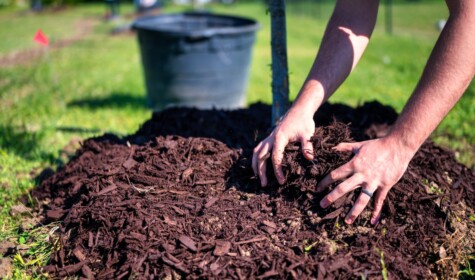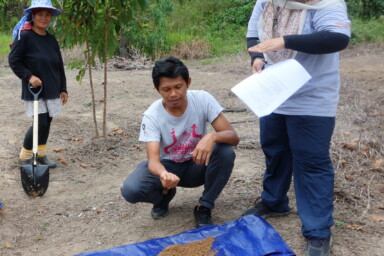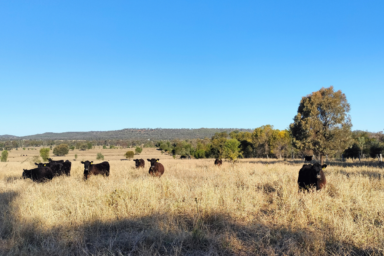Although many of us associate carbon offsetting schemes with planting trees, there is an increasing focus on restoring soil carbon. Improving the health of soils, particularly on agricultural land, enables them to be more productive, to host more lifeforms and to sequester more carbon, making soil health a critical factor in our response to climate change and biodiversity loss.
There has been significant progress and an encouraging move towards valuing soil health over the past few years. The UK Government, in the Environmental Improvement Plan 2023, has stated that it will publish “a baseline map of soil health for England by 2028 and bring at least 40% of England’s agricultural soil into sustainable management by 2028.” It plans to do this by public and private means with the Agricultural Transition Plan 2021 to 2024 which contains schemes incentivising and helping farmers to adopt nature-friendly farming practices, and a Green Finance Strategy to encourage more private investment. The goals are ambitious – to transform the management of 70% of our countryside and to raise more than £1 billion in private finance to support nature recovery by 2030.
Understanding carbon offsetting, carbon credits and how credits are valued
A carbon credit is a standardised unit that allows the holder to emit one tonne of carbon dioxide. To put this into perspective, the average person in the UK emits 4.87 tonnes per year.
Many countries now have compulsory trading schemes that issue companies and organisations with carbon credits for their emissions. Any surplus can then be bought and sold via trading scheme markets. A carbon offset tends to refer to credits being traded on a voluntary market where companies – and individuals – can buy into carbon offsetting schemes to compensate for their emissions.
Putting a value on this carbon (and other greenhouse gases) is not a simple matter and various pricing mechanisms exist. These all have at their core the need to value carbon in a way that disincentivises polluters and supports the transition to a decarbonised economy – but there is often disagreement about the most efficient way to do this. Carbon taxes, emissions trading schemes such as the UK Emissions Trading Scheme, internal carbon pricing and voluntary carbon offset markets are all ways of assigning a value to emissions.
Of these, the voluntary carbon offset markets, where credits can be bought to offset carbon emissions, have attracted particular interest. These offset programmes are supplied by governments or private entities that develop carbon removal or reduction schemes – such as farmers investing in nature improvement. There is also growing interest in these markets from investors who see them as profitable in their own right. The voluntary carbon offset market is expected to grow from US$2 billion in 2020 to around US$250 billion by 2050, so this is an area that farmers need to tap into. There is, however, some concern that growth of these markets will result in land being taken out of production to create carbon offset credits that can then be traded. This is generating some tension in the farming community with calls for a ‘land sharing’ approach to enable the transition to nature-positive farming, rather than a ‘land-sparing’ approach that separates farming from nature. Many have pointed out that using productive farmland for financial gain rather than producing food may not be the best result for farmers or the environment, if we then need to import more of our food from areas where we have no ecological control.
Government support
So, back to improving agricultural soils: how are farmers being helped to store soil carbon and access these growing carbon markets?
The Sustainable Farming Incentive is a scheme that forms part of the Agricultural Transition Plan and aims to help farmers improve the environment, animal health and welfare and reduce carbon emissions. In terms of improving soil health, it details three standards – arable and horticultural, improved grassland and moorland. Farmers can apply for a payment per eligible hectare to improve soil health, structure, organic matter and biology.
To qualify for the payment, farmers will need to carry out a soil assessment, create a soil action plan, test organic matter, minimise bare ground over winter and establish and maintain herbal leys. Currently, there are two standards to work towards – introductory and intermediate with an advanced standard proposed by 2025.
Unlocking private finance
A vital part of the Government’s pledge to unlock £1 billion of private investment in nature improvement by 2030 is the development of ‘nature markets.’ Nature markets work by creating units or credits that can be traded, allowing business to invest in environmental projects, nature restoration and regenerative agriculture such as improving soil carbon sequestration or restoring grassland habitats. These markets can be voluntary or compliance based.
At present, the UK has two voluntary markets that allow companies to compensate for emissions – the UK Woodland Carbon Code and the UK Peatland Code. These codes ensure that carbon credits are of high integrity and independently verified.
An example of a compliance market is the recently introduced Nutrient Neutrality, a market in nutrient credits where companies must mitigate their impact on water quality in sensitive areas.
In addition to this, there are many pilot markets in development including obtaining carbon credits from soil, hedgerows and natural habitat restoration as well as through using new carbon capture technologies. The Environment Improvement Plan 2023 mentions a growing interest in an agricultural soil carbon market and that DEFRA will support the development of markets for ecosystem services. The Nature Market Framework, published this March, outlines a framework for scaling up private investment in nature recovery and sustainable farming. Private companies such as Agreena are also offering farmers additional revenue streams by carrying out activities that produce carbon credits or certificates.
So, markets are beginning to develop, but what barriers do farmers face in accessing them?
Measurement
Investors need a high integrity, robust and trustworthy standard or benchmark (such as the UK Woodland Code) that can be used to put a market value on carbon offset projects. But measurement and assessment of projects to determine their carbon offset potential is complex and can be expensive, particularly for small scale farmers and land managers.
Fortunately, there are schemes and toolkits evolving that aim to help farmers and food producers speak a common language both in terms of measuring the environmental impact of schemes and providing investors with a baseline of data to support investments. One such scheme is the Global Farm Metric developed by the Sustainable Food Trust (SFT) in collaboration with a wide coalition of partners, that “enables farmers to understand the social, economic and environmental sustainability of their system in a way that is robust, holistic and independent of any particular farming philosophy”. The Soil Carbon Project is another scheme that uses scientifically robust methods to measure soil health and carbon sequestration.
Scale
Scale is another barrier, in England 40% of farms are under 20 hectares in size, making it difficult to develop carbon offset projects that are large enough to take to market.
The Nature Market Framework proposes that farmers and landowners can benefit from ‘stacking and bundling’ credits from the same piece of land, e.g., a parcel of land can produce both soil carbon sequestration and water quality credits. It also states that both public and private finance can be sought as long as there is no double counting. This will enable farmers and landowners to benefit from the full range of ecosystem services that their land offers, even on smaller farms.
Additionally, there are a number of private and government-supported aggregation schemes and funds that assist farmers and landowners to combine their resources and develop projects to the point where they can attract investment. The Green Finance Institute has been commissioned by Defra to develop an online toolkit to help farmers access private sector investment and the Natural Environment Investment Readiness Fund is supporting a total of 86 nature projects towards gaining private investment.
Farmer Clusters is an initiative developed by the Game and Wildlife Trust to bring farmers together along with a conservation advisor to deliver projects on a larger scale. The Countryside Stewardship Farm Facilitation Fund funds groups of farmers to improve local environmental outcomes and the Nature Friendly Farming Network aims to unite farmers who are passionate about wildlife and sustainable farming.
So, while challenges still exist, particularly around access to markets and ensuring trustworthy and reliable standards, there is huge financial growth potential in carbon offset and nature markets. However, there are also dangers that should be considered, and it is essential that soil carbon credits really do work for farmers and the climate. In particular, carbon sequestration must be robustly measured and verified and it’s also important that farmers don’t sell away their capacity to meet their own net zero targets. Additionally, we need to ensure that companies, especially those that pollute, have genuinely taken every step to reduce their emissions before buying credits – it shouldn’t be a fast track to a very greenwashed net zero. And, of course, there is a need to avoid contracts and schemes that promote practices that are environmentally damaging.
Ultimately, offsetting is only part of the solution to achieving net zero, but it is one that is now beginning to deliver on a broad range of environmental projects from soil carbon sequestration and sustainability to water quality and habitat restoration. Alongside government incentives, it is hoped that carbon offsetting and the newly evolving nature markets will help farmers profitably produce good quality food from a sustainably managed and healthy landscape.







